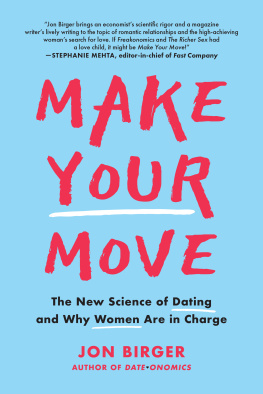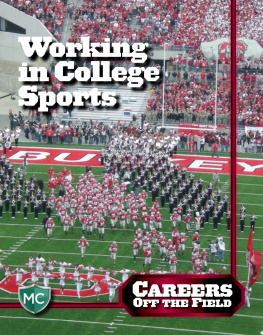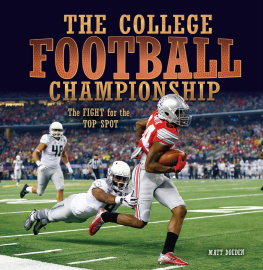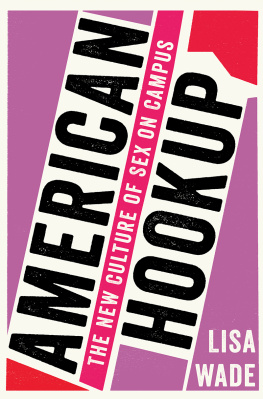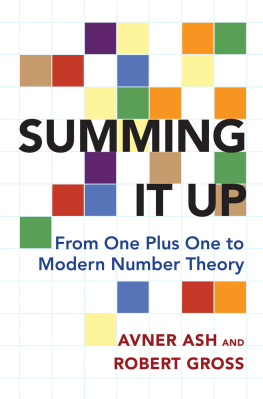DATE ONOMICS
How Dating Became a Lopsided Numbers Game
Jon Birger
Workman Publishing
New York
Contents
Chapter 1
The Man Deficit
My friend Sarah Donovan is a gem. Shes kind. Shes funny. Shes an Ivy Leaguer, and a head-turner too. Professionally, Sarah is a star: a top journalist as well as a familiar face and voice on television and radio.
Sarah is also 41 years old and unmarried. And it is this predicamentone that saddens Sarah, perplexes her friends, and frustrates her parentsthat is the catalyst for this book. American cities are filled with Sarah Donovanseducated, successful, personable, often attractive women whose dating woes make little sense to those around them. Their stories are well chronicled in novels, movies, and TV shows, from Bridget Joness Diary to Sex and the City to Girls. On-screen, these tales usually have happy endings. In real life? Its not so easy. Come to think of it, I dont think Ive ever had someone ask me if they knew any nice girls for their son, said Jeffrey Sirkman, the longtime rabbi at Larchmont Temple in Larchmont, New York, and a keen observer of the marriage market. But just about every week some mother or father will ask me whether I know of any nice guys for their daughter. Why is that?
Why indeed. Why is it that women like Donovan struggle to find marriage-material men even as male counterparts with less going for them seem to have little trouble with the opposite sex? Attempts to answer such questions have spawned a cottage industry of self-help books for womendating guides that portray the failure to find Mr. Right as a strategic problem, one that can be fixed by playing hard to get or by following a few simple dating rules. Underlying all such advice is an assumption that the perceived shortage of college-educated mena phenomenon that I call the man deficitis actually a mirage. At birth there are more boys than girls: 1.05 boys are born in the U.S. for every 1 girl. So if college-educated women just become better datersif they can get inside mens heads and understand what makes them committhere should be enough college-educated men out there for everyone.
But what if the problem is not strategic? What if most of the good men are taken? What if a disproportionate number of the single guys still out there really are incorrigible commitment-phobes just looking for a good time? What if it doesnt just seem as if theres a third more single women than men in every semi-upscale bar in Manhattan or Dallas or L.A.? What if the demographics actually bear that out? What if the hookup culture on todays college campuses and the wild ways of the big-city singles scene have little to do with changing values and a whole lot to do with lopsided gender ratios that pressure 19-year-old girls to put out and discourage 30-year-old guys from settling down?
What if, in other words, the man deficit were real?
Well, it is real, and the numbers are so shocking its a wonder they are not talked about incessantly. According to 2012 population estimates from the U.S. Census Bureaus American Community Survey, there are 5.5 million college-educated women in the U.S. between the ages of 22 and 29 versus 4.1 million such men. In other words, the dating pool for college graduates in their twenties really does have 33 percent more women than menor four women for every three men. Among college grads age 30 to 39, there are 7.4 million women versus 6.0 million men, which is five women for every four men. These lopsided gender ratios may add up to sexual nirvana for heterosexual men, but for heterosexual womenespecially those who put a high priority on getting married and having children in wedlockthey represent a demographic time bomb.
How exactly did gender ratios for the college educated get so skewed? The simple answer is that women have been attending college at higher rates than men since the 1980s, and at a much higher rate since the late 1990s. In 2012, 34 percent more women than men graduated from four-year colleges, and this gaping gender gap in college education spilled over into the post-college dating pool long ago. The shortage of college-educated mena 1.4 millionman deficit among those 22 to 29has been exacerbated by the increased reluctance of college-educated Americans to marry those lacking a college degree. According to separate research published by University of Pennsylvania economist Jeremy Greenwood and by UCLA sociologists Christine Schwartz and Robert Mare, educational intermarriage is less common today than at any point over the past half century.
As poor as the marriage market may be for educated, 40-something women like my friend Sarah, the long-term outlook for young millennial women is decidedly worse. In the U.S. there are 39 percent more college-grad women age 24 and younger than there are men in the same age cohort, according to Census data. (The man deficit is larger post-college than during college in part because foreign students are disproportionately male.) In Manhattan, the pool of 24-and-under college grads has 38 percent more women than men. In Raleigh, North Carolina, the gap is 49 percent. In Miami and Washington, D.C., its 86 percent and 49 percent, respectively. Los Angeles: 37 percent. Moreover, for reasons Ill explore later involving the demographics of the gay and lesbian community, the Census numbers probably understate the true size of heterosexual gender gaps in LGBTQ-friendly cities such as Miami, New York, and L.A. The bottom line is that by the time todays educated, early-twenties women are ready to marry, theyll be confronted with a marriage market far more daunting than the one their older cousins or younger aunts graduated into twenty years ago. Meanwhile, young male college grads now enjoy such an overabundance of sexual options that it will be interesting to see when (or if?) some of these men choose to settle down.

This book will make the case that the college and post-college hookup culture, the decline in marriage rates among college-educated women, and the dearth of marriage-material men willing to commit are all by-products of lopsided gender ratios and a massive undersupply of college-educated men. The conventional explanations for these trends all seem rooted in a kind of social entropy in which male-female relations naturally devolve from the traditional to the libertine. Despite a wealth of academic research showing how sex ratios affect dating behavior, demographics never seem to be part of the conversation.
Consider a 1,900-word New York Times article from January 2013 on the citys hookup culture. The Times storyheadline: The End of Courtship?documented the demise of traditional first dates as well as the rise of debauched one-night stands and the pseudo-relationships that follow. Hey babe, what are you up to this weekend? was the Thursday night text message one guy would send his off-and-on sex partner. The Times story blamed the hookup culture on everything from technology (Online research makes the first date feel unnecessary) to the lousy economy (Faced with a lingering recession, a stagnant job market, and mountains of student debt, many young peopleparticularly victims of the mancessionsimply cannot afford to invest a fancy dinner or show in someone they may or may not click with).
Not once did the Times mention gender ratios or the fact that New York City has 100,000 more women than men who are college educated and under age 35. In New York, with a new crop of college grads arriving every summer, the citys dating pool is like a market that just wont clear, said Andrew Beveridge, a demographer and sociology professor at New Yorks Queens College. Consider Murray Hill, which has become a hot neighborhood for young Manhattan singles. According to Census tract data, in the age 20 to 29 cohort, there are 2.3 never-married women in Murray Hill for every 1 never-married man. In the trendy, club-filled Meatpacking District, there are 2.2 never-married women for every 1 never-married man. With numbers like these, its no wonder that men feel no rush to marry and that women stop playing hard to get.
Next page

